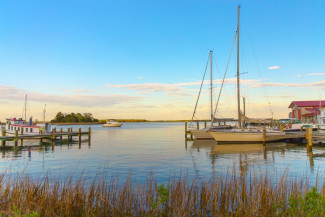
Johns Hopkins UniversityEst. 1876
America’s First Research University
An Environmental History of the Chesapeake Bay with Victor Kennedy

Chesapeake Bay is viewed these days as a rich fisheries and hunting environment, but few know that it was even more productive than now. Once described as an immense protein factory, the Bay, along with its fisheries and waterfowl harvests, has changed radically over the past 150 years. If we are unfamiliar with the extent of these changes, our reference point, or baseline, for restoring the Bay may be set too low.
A baseline tells us how things used to be, but ecosystems can deteriorate so gradually that each human generation affected by the changes takes its present situation as the norm. Thus the baseline for the present generation is different from the baseline for the preceding generation, and so on back in time. The baseline--our perception--has shifted.
Understanding the shift involves understanding the historical ecology of the Bay, both to appreciate what has been lost in the harvest abundances and to help us think about what baselines to use in restoring the system. This book will illustrate the rise and fall of the Bay’s fisheries and waterfowl harvests, beginning in colonial times but especially focusing on the 19th century.

From the time of the first European colonists to the late 1800s, Chesapeake Bay was celebrated for its aquatic bounty, feeding multitudes and eventually supporting great industries. In the late 19th century an extensive infrastructure of boats, harvest gear, and processing facilities exploited this bounty. Fishers harvested multiple millions of shad, river herring, oysters, and blue crabs and multiple thousands of sturgeon and terrapins. Market hunters shot many thousands of waterfowl for sale. Processors salted and smoked fish, canned oysters, turned terrapins into gourmet food, cleaned waterfowl, and picked crab meat and nurtured soft crabs. Coopers made thousands of wooden barrels for salt fish and tinsmiths handcrafted thousands of cans for oysters. Net makers wove miles of fish netting. Carpenters built sailboats for oyster dredgers, oyster tongers, and crab trotliners. Sail makers made sails, rope makers made ships’ cordage and crab trotlines, and blacksmiths forged oyster dredges and tongs and crab scrapes. Railroads and steamships delivered seafood from tidewater communities to markets nationwide and overseas. The richness of the 19th century fisheries supported work for thousands more people than now. As the fisheries were over-exploited, the bounty was squandered. There are now bans on harvesting shad, river herring, sturgeon, and terrapins and there are bag limits for waterfowl.
This book uses eye-witness reports by colonial writers, but especially by 19th century fishers, managers, scientists, and newspaper reporters, to reveal what Chesapeake Bay’s aquatic resources were once like. There have been intermittent reports of the state of individual fisheries and waterfowl populations over the decades, but this book assembles a trove of information on harvest abundances across a diversity of fishing and waterfowl industries. It also describes warnings by scientists and informed observers about the folly of continuing business as usual, warnings that were usually downplayed by harvesters and politicians even into the 20th century.
I assembled this history to celebrate the bygone ecological wealth of the Bay and to help readers understand the Bay’s potential for restoration, even if we cannot completely re-establish the numbers of fish, terrapins, and waterfowl that once supported great economic wealth for harvesters and processors. With an understanding of the Bay’s past richness, perhaps we can set ambitious restoration goals for this once-renowned protein factory.
Victor S. Kennedy is emeritus professor at the University of Maryland Center for Environmental Science. He is a coeditor of Ecology and Conservation of the Diamond-backed Terrapin, The Eastern Oyster: Crassostrea virginica, and The Blue Crab: Callinectes sapidus. He is also the author of Shifting Baselines in the Chesapeake Bay: An Environmental History.

